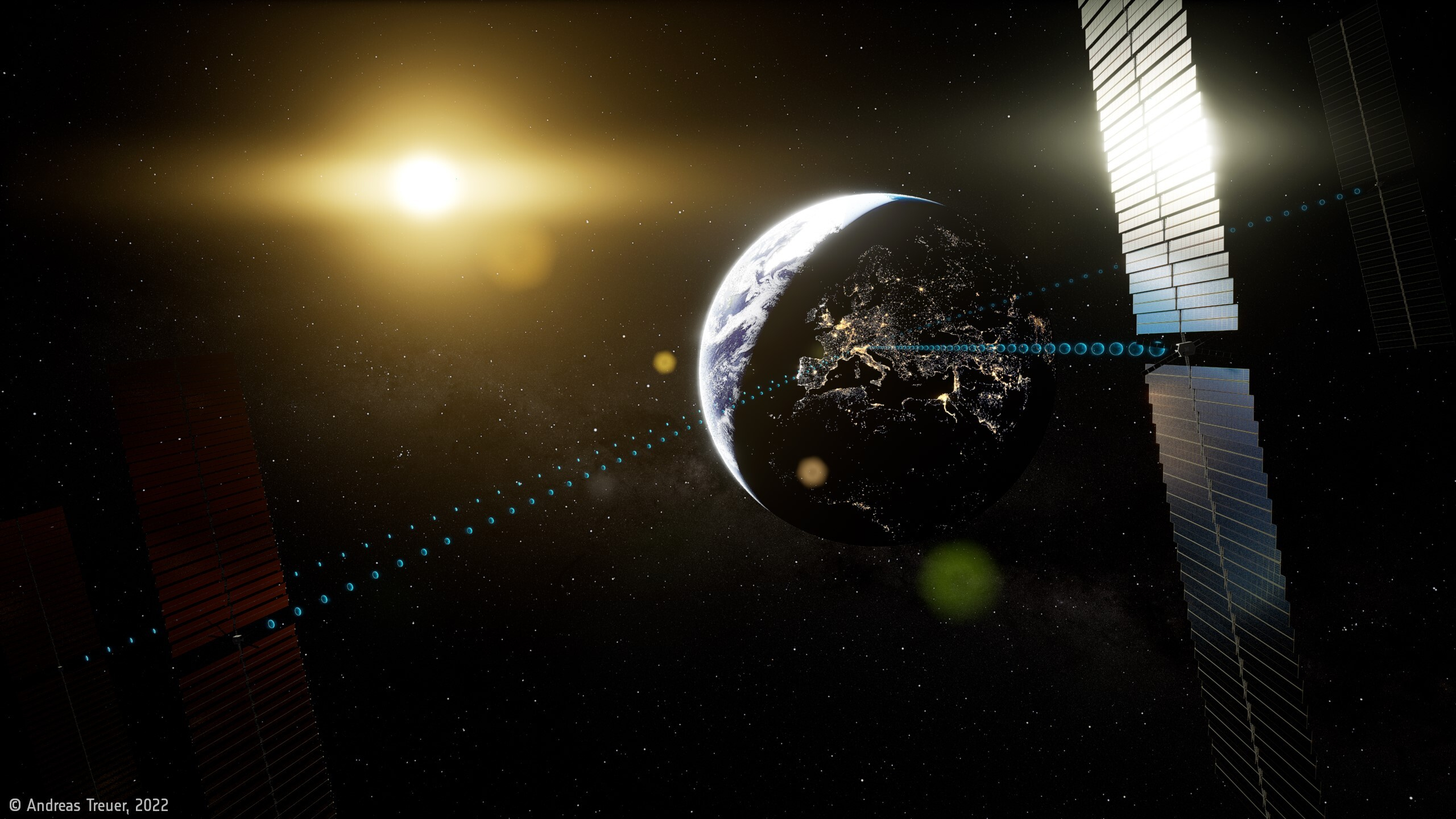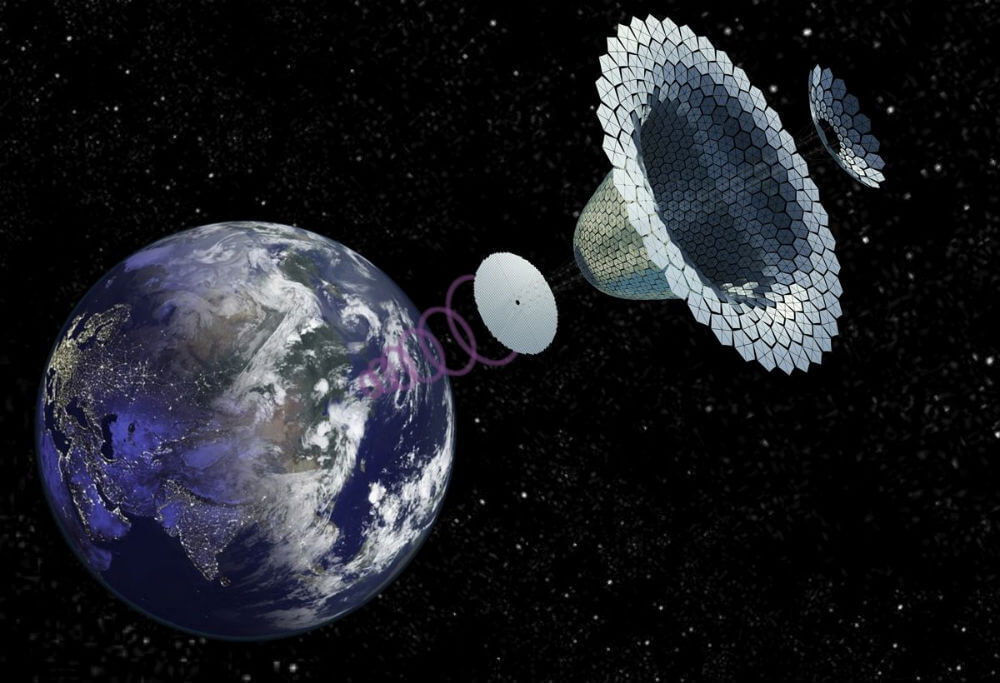Is it time to put a dimmer switch on the push for space solar power?

"In 2-3 years, a thousand times more power. There's going to be an incredible amount of progress, then the cows are out of the barn."

The thought of beaming power to an energy-hungry Earth from space has long been studied. It was first proposed over 80 years ago in science fiction.
"It was quiet in the officer's room of Solar Station #5 - except for the soft purring of the mighty Beam Director somewhere far below," wrote renowned author Isaac Asimov in his April 1941 story "Reason" appearing in the magazine "Astounding Science Fiction."
Asimov had his characters tending a solar energy collection station in space that routed energy rays to receivers on Earth, as well as Mars. Fast forward to the 21st century, and investigations here on Earth and now in space seemingly bolster the concept. Still, space solar power beaming is viewed by some as a truly far out and off-the-beam technology, an economically dubious concept that does make for good science fiction. Space.com reached out to several technologists to ask what's new, what's old and what's still missing in terms of transmitting power to Earth from space.
Related: Scientists beam solar power to Earth from space for 1st time ever
Trio of technologies
Caltech's Space Solar Power Project (SSPP) is seen by some as a glimmer of hope for the technology.
Over a year has passed since SSPP demonstrator technology was launched into the test bin of Earth orbit. Once in orbit, the SSPD-1 spacecraft tried out a trio of technological innovations crafted to help swing the space solar power needle closer to full reality. They were:
- DOLCE: A Deployable on-Orbit ultraLight Composite Experiment to showcase a novel packaging scheme and deployment.
- ALBA: 32 different types of photovoltaic (PV) cells to appraise how they withstand the harsh space environment.
- MAPLE: A Microwave Array for Power-transfer Low-orbit Experiment based on custom integrated circuits with precise timing control to focus power selectively on two different receivers to demonstrate wireless power transmission at distance in space.
Take it to the limit
"Many things worked, and the things that worked well we pushed them until they stopped working," said Ali Hajimiri, co-director of the Caltech Space-Based Solar Power Project.
Breaking space news, the latest updates on rocket launches, skywatching events and more!
Hajimiri has been focused on integrated circuits and their applications in various disciplines, such as biotechnology, communications and sensing, that span a wide range of frequencies from high-speed and radio frequency to low-frequency high-precision circuits.
Yes, Hajimiri pointed out, there were hitches over the nine month long SSPD-1 mission. "We had a literal snag in deployment, but the team worked it out. Even in the wireless energy transfer, we had all sorts of situations. Then we really stressed the system towards mission end — to the point where we tried to actively cause damage."
Rooftop realization
On May 22, 2023, the payoff from SSPD-1 literally hit the roof atop Caltech's Gordon and Betty Moore Laboratory of Engineering. For just 90 seconds, the spacecraft's MAPLE hardware beamed down energy to Earth that was harvested in space.
Hajimiri is quick to explain that the level of energy received at roof-level was ultra-small. It was mostly about detection, he said, but the real buzz is to consider the modest amount of energy received as one small step for space solar power.
SSPD-1 is going to be decommissioned soon and left to take a destructive plunge into Earth's atmosphere.
The project's attention is now turning to solving issues like scaling up, enabling autonomous deployment, and developing more lightweight structures.
Unknown unknowns
"There's a lot of 'unknown unknowns' that still need to be figured out," said Hajimiri. At this phase of the work the team is looking at manufacturing processes for fabric-like, low cost arrays. Also, timing synchronization is quite challenging especially on a flexible, floppy structure wafting about in space.
"We've developed new ways of thinking about this problem," Hajimiri added, "ways that an array can itself determine its own shape and make corrections for that through its electronics."
Even with SSPD-1's 'goodbye and so-long' status, a slew of invaluable milestones were met, Hajimiri said. "The biggest challenge is raising awareness and to make the case clear that what we did is real."
Scalable solution
There is no clean, firm, dispatchable energy technology other than Space-Based Solar Power (SBSP) is the view of Troy, Michigan-based Virtus Solis Technologies Inc.
John Bucknell is the CEO and founder of the group. "Those of us that have compared all the viable energy technologies know that a scalable solution needs to be low complexity, low mineral intensity, mass manufacturable and able to deliver firm, safe, low-cost e-power like fossil fuels have for the last 200 years," he said.
Bucknell and colleagues are blueprinting an SBSP system that fills all those criteria — a constellation of 16 arrays in space that each pump out 20 gigawatts of power. Collectively, 320 gigawatts can be delivered to anywhere on the planet, he said, a system scalable to become much larger.
"With 50 percent year-over-year growth in capacity, SBSP could get to 100 terawatts of generation in 30 years and satisfy the needs of a 10 billion population planet," said Bucknell.
Disconnect
"There is still the disconnect between academic studies and aerospace prime manufacturing cost studies and what private industry can achieve," Bucknell believes. "As a result, our forecast of $200 million to complete the research and development and get a functioning pilot plant in orbit seems unbelievable."
For Bucknell's money, and investors too, it is the energy industry that needs to hear and understand these options, he suggested, rather than the space industry.
"SBSP still sounds like science fiction because they don't know that the underlying technologies have all matured and just needed commercial space launch to make it happen. Virtus Solis was the first to incorporate around this opportunity," said Bucknell, "designed from the ground up to a cost target to address the global energy market."
Investors want to see there is no risk towards revenue, Bucknell observed. "An orbital demonstration means you have a real product, so the remaining risk around on-orbit assembly and power transmission has been demonstrated and then the product can scale."
Standing room only
A leader in advocating harnessing solar energy from space is John Mankins of Artemis Innovation Management Solutions in Santa Maria, California.
Mankins took part in an April International Conference on Solar Energy from Space hosted by the European Space Agency (ESA) and the UK Space Agency at the Royal Aeronautical Society in London.
"It was standing room only," Mankins recalls. "Almost none of the 200 people were the regular players, and that was a huge change," be it researchers from China working on space-based power plant technology to Europe's SOLARIS initiative. There's ongoing work in the UK, as well as progressive looks into power beaming in Japan and other countries, he said.
Reusable readiness
Mankins said the foundations for power beaming have been laid over and over again by experiments on the ground. "To me, power beaming as a function was demonstrated decades ago," he said, "and now the real issue is how to do really big systems."
For any kind of mega project in space, "the most visible hurdle to space solar power appears to be ready to fall," advised Mankins, and that is low-cost, reusable launchers.
Reusable rocketry has been spearheaded by SpaceX and its Falcon-class boosters and now the huge Starship flight program. Similarly, Blue Origin's New Glenn launcher is nearing its first flight. Other nations are also pursuing reusable readiness in the booster business, such as ESA and China.
Power up
Nevertheless, there's work to be done in the coming years.
Pointing to the future, Mankins said that systems-level demonstrations can tackle issues like finding the right design, or determining how well the technologies can scale and at what price. It's also vital for spacecraft engineers to look into what's rapidly taking place in robotics down here on Earth and apply it to in-space construction.
Moreover, power beaming from space needs to go beyond Caltech's nano-watts per square centimeter experiment to micro-watts per square centimeter, Mankins advised.
"But in 2-3 years a thousand times more power. There's going to be an incredible amount of progress," Mankins foresees, "then the cows are out of the barn."

Leonard David is an award-winning space journalist who has been reporting on space activities for more than 50 years. Currently writing as Space.com's Space Insider Columnist among his other projects, Leonard has authored numerous books on space exploration, Mars missions and more, with his latest being "Moon Rush: The New Space Race" published in 2019 by National Geographic. He also wrote "Mars: Our Future on the Red Planet" released in 2016 by National Geographic. Leonard has served as a correspondent for SpaceNews, Scientific American and Aerospace America for the AIAA. He has received many awards, including the first Ordway Award for Sustained Excellence in Spaceflight History in 2015 at the AAS Wernher von Braun Memorial Symposium. You can find out Leonard's latest project at his website and on Twitter.



